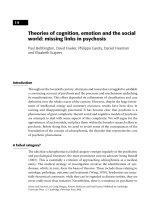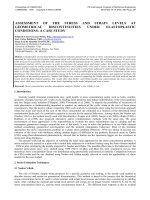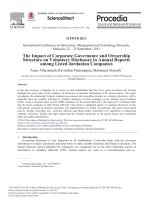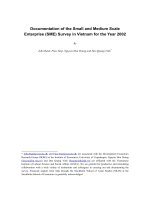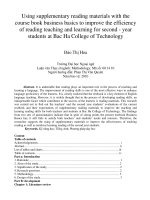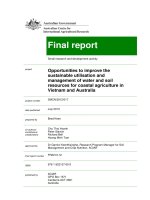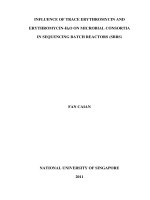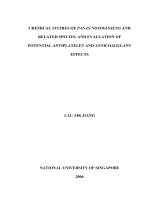EVALUATION OF IMPACT OF HYBRID RICE AND purebred RICE ON SUSTAINABLE AGRICULTURE IN BAC KAN PROVINCE – CASE STUDY IN CHU HUONG, THUONG GIAO COMMUNES BA BE DISTRICT AND TU TRI, TAN TIEN COMMUNES BACH THONG DISTRICT
Bạn đang xem bản rút gọn của tài liệu. Xem và tải ngay bản đầy đủ của tài liệu tại đây (7.47 MB, 46 trang )
Center for Sustainable Rural Development
No. 56, Lane 19/9, Kim Dong Str, Hanoi, Vietnam
Tel: 84-4-3943-6676/78
Fax: 84-4-3943-6449
Email:
Website: www.srd.org.vn
RESEARCH REPORT
By Nguyen Minh Duc, Do Truong Lam and
Hoang Thi Huong Tra
EVALUATION OF IMPACT OF HYBRID RICE AND purebred RICE
ON SUSTAINABLE AGRICULTURE IN BAC KAN PROVINCE – CASE
STUDY IN CHU HUONG, THUONG GIAO COMMUNES- BA BE
DISTRICT AND TU TRI, TAN TIEN COMMUNES- BACH THONG
DISTRICT
(Hanoi, October 2010)
We inherit CIDSE Vietnam’s 28 year experience
(CIDSE – Coopération Internationale pour le Development et la Solidarité)
1
TABLE OF CONTENTS
1 INTRODUCTION................................................................................................................. 4
2 RESEARCH METHODOLOGY........................................................................................ 10
3 RESEARCH FINDINGS.................................................................................................... 16
4 CONSLUSION AND RECOMMENDATION................................................................... 41
LIST OF TABLES
Table 1 - Volume, value and average price of export rice of Vietnam from 1998 to 2009 .....5
Table 2 - The structure of the area under rice varieties through the years...............................7
Table 3 - The age of household, labor and the number of people of the surveyed households
13
Table 4 - Education level of household surveys by the type of household...........................13
Table 5 - The change in the area and investment for hybrid rice production.........................16
Table 6 - The change in area, investment and income from purebred rice of surveyed
households in 5 last years.......................................................................................................17
Table 7 - Number/ rate of households having material for rice production...........................18
Table 8 - The area and productivity of purebred rice and hybrid rice of surveyed households
in 2009....................................................................................................................................19
2
Table 9 - The number of households cultivating hybrid rice and purebred rice by crop in
2009 .......................................................................................................................................20
Table 10 – Rice variety planted pattern in the harvest crop in 2009 (% surveyed household)
20
Table 11 – Pattern of planted rice varieties in the spring crop of 2009 (% surveyed
household).............................................................................................................................. 21
Table 12 - Sources of rice seeds of surveyed household by crop in 2009..............................22
Table 13 - The situation of rice consumption of surveyed household in 2009...................... 23
Table 14 - Structure of household with non-agricultural production .................................... 24
Table 15 - The situation of revenue’s sources of surveyed households in 2009 (million) ....24
Table 16 - Comparison of some criteria between hybrid rice and purebred rice...................25
Table 17 - Chemical medicines in the spring crop (Thousand/1000 m2) .............................28
Table 18 - Medical medicines in the harvest crop (thousand vnd/1000 m2) ........................29
Table 19 – Chemical fertilizers in the spring crop (kg/1000 m2) .........................................30
Table 20 - Income from rice in the spring crop in 2009 (Average of 1000m2) ....................31
Table 21 - Income from rice in the harvest crop in 2009 (average of 1000m2) ....................32
Table 22 - Comparison of productivity between hybrid rice and purebred rice.....................33
Table 23 - Causes of stability of rice productivity ................................................................ 33
Table 24 - Comparison of resistant cold, resistant drought and ease sale between purebred
rice and hybrid rice.................................................................................................................34
Table 25 - The training situation of purebred rice of surveyed households...........................35
Table 26 - The situation of hybrid rice training of surveyed households...............................36
Table 27 - The number of surveyed household borrowing ...................................................37
Table 28 - Situation of borrowing of surveyed households ..................................................38
Table 29 - Purposes of borrowing loan of households........................................................... 39
Table 30 - SWOT analysis in the production of purebred rice and hybrid rice of households
in 2009 ...................................................................................................................................39
3
1
1.1.
INTRODUCTION
Background
The overview of rice production in Vietnam
Rice production plays a particularly important role to the agricultural production of the
country. It plays an important role to food security, income generation, job creation and
foreign currencies gains for Viet Nam (Bernabe 2008). In 2007, rice area accounts for 45%
of the area of total agricultural land in the country (GSO 2008). Rice is the staple food crops
and the main source of income of farmers. It is also a crop of the high export value. Hybrid
rice has been planted experimentally in northern Vietnam since 1991, and soon its area was
brought into cultivation on the large scale due to their advantages in productivity.
There are two largest rice production regions in Vietnam, which are Red River Delta and
Mekong River Delta. Rice yield of two deltas accounts for 70% of the country’s total. Both
these plains are accreted by the alluvium of the Red river and Mekong river, land in these
two areas are very fertile so that rice productivity is very high. One reason is that in two
areas has tradition of rice cultivation, so intensive farming level of people is very high that
lead to high productivity compared to national productivity and higher than other areas.
Yield of The Red river delta is 54.4 quintals per hectare, yield of The Mekong is 50.3
quintals per hectare while the average of national yield is 48.9 quintals per hectare
(AGROINFO 2009)1.
Since 1988, after the policy “renewal’’ through Resolution 10, the rice production in
Vietnam increased clearly. In later years, the country gained the amount of rice export yield
significantly of about 1.4 million tons, worth $ 290 million. In the year after that, the
quantity of rice annually was about 2-3 million tons per year. In 1998 it exported 3.7 million
tons, and nearly 6 million tons in 2009. In 2009, Vietnamese rice exports went to 20 major
markets, but mainly to the Philippines, Malaysia, Cuba and Singapore. Exporting to the
Philippines reached the largest with over 1.7 million tons, worth 917.13 million USD,
accounting for 28.7% of rice export and 34.4% of export turnover; followed by export
turnover to Malaysia reached 272.19 million, accounting for 10.22%; then to Cuba reached
191 million USD, accounting for 7.17%; to Singapore reached 133.6 million USD,
accounting for 5.02% (see graph 1)2.
AGROINFO (Information Center for Agriculture and Rural Development). 2009. Vietnam
Rice Yearbook 2008 and Outlook for 2009.
2
2009, Asia market plays a important role in rice export of Vietnam
and The rice export market of Vietnam
2009 />1
4
Table 1 - Volume, value and average price of export rice of Vietnam from 1998 to 2009
Year
1998
1999
2000
2001
2002
2003
2004
2005
2006
2007
2008
2009
Volume
(million tons)
3.8
4.5
3.5
3.5
3.2
3.8
4.1
5.3
4.6
4.6
4.7
6.0
Value
(million USD)
1024
1025
667
586
726
721
950
1407
1276
1490
2894
2664
Average prices
(USD/ton)
273.2
227.4
191.9
166.2
223.9
189.0
234.1
268.0
274.8
326.9
610.4
447.1
Source : Vinanet 20093
Graph 1: Market Structure of Vietnam's rice exports in 2009 (% yield)
other
countries
38.3
Philippines,
28.7
Malaysia,
10.3
Ukrainian,
0.6
Africa, 0.6
Hongkong,
0.7
Russia 1.4
Cu ba, 7.6
Iraq, 2.9
Taiwan, 3.4
S ingapore,
5.5
Source: />
Hybrid rice production
Hybrid rice and its development in Asia
3
Exported-imported rice data from 1998 to 2010. />and />
5
Hybrids are produced by crossing two inbred – genetically fixed – varieties of a particular
crop. Hybrids are special because they express what is called "heterosis" or hybrid vigour or
the tendency of off springs to perform better than either of the parents in one or more
physical or agronomic traits, particularly in terms of yield. Since its discovery, heterosis has
been exploited to produce crops with traits that have high commercial value, especially in
terms of higher yields.
According to Elenita C. Daño (2006) the demonstration of heterosis in rice has been
observed as early as 1926. However, hybrid rice research began in China only in 1964 and
began to bear fruit in the 70s. The first commercial hybrid rice was developed and was made
available to Chinese farmers in 1976. At the same period of time, East Asian countries were
dazed with excitement over the breakthroughs in rice breeding coming out from the newly
established IRRI under the optimistic banner Green Revolution. IRRI developed and
released the first “miracle rice”, code-named IR-8 in 1966. It brought significant yield
increases in rice production with an average yield of around 10 tons/hectare. IR-8’s genetic
potential has been so dramatic that it has never been surpassed by subsequent modern
varieties developed by IRRI.
The developments in hybrid rice in China encouraged IRRI to explore the potentials and
challenges of the technology outside China. The first commercial hybrid rice developed by
IRRI was released in Vietnam in 1993. This has been subsequently followed by limited
releases in India and the Philippines.
Because of the need to develop their own hybrid lines, many countries have initiated their
own hybrid rice research activities. By 1998, the Asian countries that carried hybrid rice
research in their agricultural programs include Korea, Philippines, India, Indonesia,
Republic of Korea, Vietnam, Malaysia, Thailand, Japan, Sri Lanka, Bangladesh and
Pakistan.
Most of the countries in Asia that adopted hybrid rice cited the need to provide food for the
expanding population as their main reason for adopting the technology. More than two
decades after the first discovery and development of hybrid rice in China, the technology
has been widely tested and acknowledged in the region.
However, there are many remaining issues of hybrid rice production. They include
technological constraints such as labor-intensive; knowledge
intensive, irrigation
dependence, and yield plateau; economic concerns like location-specific performance (the
value of these yield increases seems to vary depending on location), lower net returns, poor
grain quality, high seed costs, and higher labor costs; and socio-cultural impacts, especially,
impact on the traditional rights of farmers to save and reuse seed, which probably lead to the
rice farmers’ total dependence on commercial seed companies for their seeds.
6
Hybrid rice production in Vietnam
Adoption process
Hybrid rice technology has been successfully developed in China for last decades. This
technology has helped to increase grain yield and farmers’ income and contributed to more
rural job opportunities through hybrid rice seed production in China and in other countries.
This seem to proves hybrid rice as a key factor for food security, poverty alleviation which
results in hybrid rice adoption in Vietnam.
Vietnam is considered the next success story in hybrid rice adoption, after China, but at
present, it is experiencing a setback. For Tran Duc Vien et al. (2006) and Nguyen Tri Hoan
(2003) hybrid rice, proven to have 20% yield advantage over inbred rice in China, was first
introduced in Vietnam in 1991 with demonstrations in selected provinces in the North.
Hybrid rice was then planted on a wide scale in the following year with an area of 1200 ha.
However, Vietnam has failed to reach its target of rapidly expand hybrid rice production
area (see table 1). The hybrid rice production area increased significantly at the beginning
period and reached the peak in 2003 and then slowly declined. Many farmers have stopped
growing hybrid rice because of its limitation such as high production cost and susceptibility
to pest. In 2009, although hybrid rice was grown in 40/64 provinces, the total area of hybrid
rice was only 700,000 hectares.
Table 2 - The structure of the area under rice varieties through the years
Unit: %
Year
s
1992
1993
1998
1999
2000
2001
2002
2003
2004
2005
Whole year
Hybrid
Purebred
rice
rice
0.2
99.8
0.5
99.5
2.7
97.3
3.0
97.0
5.7
94.3
6.4
93.6
6.7
93.3
8.1
92.0
7.8
92.3
4.8
95.2
The Spring crop
Hybrid
Purebred
rice
rice
0.0
100.0
0.3
99.7
1.6
98.4
1.7
98.3
3.0
97.0
4.0
96.0
4.0
96.0
4.7
95.3
4.7
95.3
4.8
95.2
The summer crop
Hybrid
Purebred
rice
rice
0.2
99.9
0.3
99.7
1.1
98.9
1.4
98.6
2.7
97.3
2.4
97.6
2.7
97.3
3.4
96.7
3.0
97.0
0.0
100.0
Source: General Statistical Office 2007
Government’s roles in hybrid rice development
The government has played a key roles in hybrid rice development. In 1992, with full
support from the government, the National Hybrid Rice Research Program was launched
7
and the Hybrid Rice Research Center (HRRC) was established. At the present, there are two
more institutions engaging in hybrid research namely, Cuu Long Rice Research Institute and
the Agricultural Genetic Institute. The government covers all financial requirement to
technical capacity building, R&D, training of researchers, and up to extension and transfer
of the technology. Consequently, hybrid rice adoption has since then increased (EARWG
2006, Elenita C. Daño 2006, Tran Duc Vien et al. 2006 )
Moreover, the government has given a massive subsidy on hybrid rice production to farmers
that enable them to adopt the hybrid rice technology. First national government offered seed
subsidy in order to rapidly introduce hybrid rice to the farmers. While seed subsidies from
the national government to hybrid rice farmers were all removed in 2003, the agriculture
ministry (MARD) continued to extend direct subsidies to farmers who commercially grow
hybrid seeds. Additionally, in the poorer mountainous regions in the north, 60 percent
subsidy on the purchase of parental and restorer lines and 40 percent subsidy for the
purchase of the required inputs such as gibberelic acid and fertilizers were extended
(EARWG 2006, Elenita C. Daño 2006).
Aside from this, roles of government structures from provincial to communal level is very
crucial in expanding hybrid rice production through the promotion and delivery of hybrid
rice seeds to. The local governments exercise control over state-owned seed enterprises
which are registered and operate locally. Local seed enterprises serve as the direct channel
of national seed companies -- which are considered private entities while the
government maintains substantial share -- in the distribution, promotion and selling of
hybrid rice seeds to farmers. The same local structure also has the discretion and power
to offer incentives for farmers to grow hybrid rice seeds, thus benefiting the local seed
enterprises in the process (EARWG 2006, Elenita C. Daño 2006).
Obviously, there were huge public investment in hybrid rice development. During the
period 1998-2006, the average import quantity of seed was recorded at 11,172 tons
yearly, valued at 14.5 million USD. Total budget spent for the extension program and
R&D in hybrid rice production from 1993-2005 is recorded at 82.4 billion VND
(approximately 5.5 million USD) (Tran Duc Vien et al. 2006, Elenita C. Daño 2006).
Existing issues
Dependence of imported seed. Over the past decade, considerable progress was made in
several national hybrid rice programs, especially in breeding research, F1 seed production,
and technology transfer. However, domestic supply of F1 seed has not been able to meet the
demand. On average, total domestically produced seeds meet 18.54% demand. Depended on
imported seed which mostly came from China (Tran Duc Vien et al. 2006, Tran Van Dat
2003, Elenita C. Daño 2006).
8
Risks. Many farmers in Vietnam encounter serious problems both economically and
technically. They experienced difficulty in marketing their produce especially in the north
and in the central regions due to the inferior quality of hybrid rice seeds, particularly in
terms of taste. Furthermore, imported Chinese rice hybrids are generally susceptible to
ragged stunt virus and brown plant hopper especially in the south and bacterial leaf
blight in the north. Although the Vietnamese government has encouraged local seed
production activities, however, many small farmers are generally reluctant to produce hybrid
rice seeds locally because of high risks involved, very high financial requirement, lack of
proper warehouses and storage space for unsold seeds, and the unavailability of pure CMS
lines (EARWG 2006, Tran Duc Vien et al. 2006, Elenita C. Daño 2006).
Unsustainable development caused by the government subsidy on hybrid rice production.
The high cost of hybrid seed production at present is resolved by the subsidies provided
by the government, specifically from the provincial and district levels in terms of direct
subsidies in addition to the indirect subsidies from the central government in the form of
research, development and extension support. If the government withdrew the subsidies,
many farmers would stop producing hybrid rice because of financial limitation as well as
economic inefficient (EARWG 2006, Elenita C. Daño 2006).
1.2.
Rationale
As mentioned above, rice production plays critical roles in national economy and farmer
household economy as well. In order to meet the country’s target of increase in rice
productivity to reach food security and poverty reduction, Vietnamese government had
invested much in the National Hybrid Rice Research Program leading to the rapid expansion
of hybrid rice production in the country. However, there are very limited researches on
sustainability of hybrid rice production, especially at farmer level. Therefore, it is reasonable
to question that will it bring risks to sustainable livelihoods of people, especially the poor
when the hybrid rice replaces purebred rice without thorough consideration.
Therefore, this research aims to synthesize the experience of hybrid rice as well as purebred
rice production at household level. With a case study in Bac Kan, a mountainous province of
Vietnam, it hopes to analyze and discuss the strategies to maintain the purebred rice seeds to
contribute poverty reduction and sustainable community development.
1.3.
Research objectives
The specific objectives of the study consist of:
-
Survey on the production of purebred rice and hybrid rice varieties in Bac Kan
9
-
Analyze the impact of hybrid rice on sustainable agricultural
( including impact on environment, economic and social)
-
Analyze the role and status of domesticated rice in the community and the system of
local rice today.
-
Survey on conditions and opportunities for farmers, especially farmers who grow
hybrid rice
-
Provide strategies to conserve and maintain the purebred rice seeds in the next time.
2
development
RESEARCH METHODOLOGY
2.1 Research site
Ba Be
are
Bach
and
and Bach Thong districts
chosen. In Ba Be, we
selected Chu Huong and
Thuong Giao commune; In
thong, we selected Tu Tri
Tan Tien commune.
Ba Be
is a mountainous district
located in the Northwest of
Bac
Kan province. Its capital
lies at
Cho Ra being on highway
279. It
is 50 km far from Ba Be to
Bac
Kan capital Northwest way.
It
Son
is
situated to the West of Ngan
district, the East of Tuyen
Quang province, North of
Cho
Don
and
Bach
Thong
district, and South of Pac
Nam
and Cao
Graph 2. Mapdistrict
of the research
site Bang
province4.
At the end of 2008, the district had a population of about 47,000. There are 5 main ethnic
groups as: Tay, Kinh, Dao, Mong and Nung. The population density is 69 persons per km 2.
Ba Be’s terrain is almost mountain area. The district covers an area of 68,412 hectares where
4
/>
10
agricultural land is 6,770, forest land is 54,876 and not used land is 13,167 hectares (Ba Be
People Committee 2009)5.
Bach Thong is also a mountain district of Bac Kan province. It is situated to the South and
Southwest of Ngan Son and Ba Be districts, the West of Na Ri district, the East of Cho Don
district, and the North of Bac Kan capital. It is 18 km far from the Bach Thong to bac Kan
capital.
Phu Thong is a township and capital town of Bach Thong district. The population of Bach
Thong is 31,585 and the total area is 546 km 2. The district is divined into one township and
16 communes. The main ethnic groups are Tay, Kinh and Dao (Bach Thong People
Committee 2009)6.
In the survey, rice production of farmers occurred in the spring crop and harvest crop. The
area and yield of these crops are affected by many factors such as weather, pest epidemic,
and irrigation water. In the spring crop with cold weather households often tend to plant
hybrid rice. In the harvest crop with dry weather, litter rain, and most of the area’s rice
farmers are not actively being water, so they often plant purebred rice varieties which resist
water such as: Bao Thai, Khang Dan. It yield is often higher than for the spring crop yield
from 20 to 40kg/1000 m2.
2.2 Research sample
In each commune, we discussed with two farmer groups, each group of 20 people.
Thus, eight groups of farmer were discussed which are about 50% of SRD project and
50% of not belong to SRD project.
In each commune, we selected randomly 20 farmers to interview by questionnaires
were designed. Thus, the total of farmers interviewed was 80.
The economical and social characteristics of the surveyed household sample
Economic condition: the farmers have mainly economic condition in the middle and nearly
poor (about 85%), the remainders are economic wealthy and poverty. It suggests that this
economy is poor. Specifically, the economic structure of these households is expressed in
the following figure:
5
6
/> />
11
Graph 3. the structure of the surveyed
household is divided by income
7.5%
Graph 4. the ethnic structure of the surveyed
household
1.2%
6.3%
6.3%
22.5%
26.2%
60.0%
Thewealthy
Theaverage
Thewealthy
Thenearly poor
Thepoor
Thenearly poor
Source: Bac Kan’s
70.0%
surveyed
households, 2010
Theaverage
TheThepoor ethnic
structure of the
surveyed households. The result shows that people in the survey area include ethnic groups
as Kinh, Tay, Nung and Dao. Tay and Nung‘s people account for the majority of 70% and
22.5% divided fairly by all types of households. This shows that ethnics make equally
economic. There is no difference in the economy between households belonging to different
ethnic.
Labor and demographic: Results showed that labor resources are abundant in this region.
Labor and average household size was 3 and 4 people. This means that each employee has 5
people attached. This is an opportunity for farmers to boost agricultural production to escape
poverty. In particular, labor and people of poor households are the lowest and most average
households. The main cause is established by the new households having low labor and in
the form of poor villages. The situation of household age, labor, and people of these
households is shown in Table 4
Table 3 - The age of household, labor and the number of people of the surveyed
households
Classification of household by income
The number of people (person)
Labor (person)
1. The wealthy
5.2
3.0
2. The average
4.9
3.5
3. The nearly poor
4.2
2.6
4. The poor
4.0
1.8
Average
4.7
3.1
12
Source: 2010 Household survey
The educational level of the head of household: The survey shows that 100% of
households with education level from primary school to high school and the difference in
education level of household surveys. The head of households with wealthy economic and
poor economic level have higher education level than others.
As the results, there is about 80% of household head in the wealthy and the poor with qualified level
of high school, the remainder is the educated level of secondary school and no one with qualified
level of under high school. The head of household in the average and the nearly poor have secondary
school’s education level (from 65% to 75%). Others qualified
high school or primary school of
education level. Especially, there is no illiterate household. This is to facilitate the transfer and
gaining the advanced technical progress in agriculture in general and rice cultivation in particular.
Table 4 - Education level of household surveys by the type of household
Education
level
of
household
head
Classification of households by income
The
wealthy
The average
The nearly
poor
Total
The poor
No.
(%)
No.
(%)
No.
(%)
No.
(%)
No.
(%)
Elementary
school
0
0.0
4
8.3
2
9.5
0
0.0
6
7.5
Secondary
school
1
20.0
31
64.6
15
71.4
1
16.7
48
60.0
High school
4
80.0
13
27.1
4
19.1
5
83.3
26
32.5
Total
5
100
48
100
21
100
6
100
80
100
Source: 2010 Household survey
2.3 Data collection techniques
Secondary data collection: data collection and published documents of the State
management agency for agriculture of Bac Kan province, and surveyed districts and
communes were gathered. The data sources are listed below:
The Department of Agriculture and Rural Development, Bac Kan plant
protection department
13
Department of Agriculture and Rural Development, Ba Be and Bach Thong
districts of The second of plant protection station.
People’s community of Chu Huong, Thuong Giao, Tan Tien and Tu Tri
Primary data collection
A combination of qualitative and quantitative data collection techniques were employed:
Consulting, discuss deeply with officials of the agencies mentioned above
Discussing with farmer group: using tools such as timeline, SWOT and
brainstorming to collect relevant data. Timeline tool used to collect data,
information on the production of hybrid rice farmers in Bac Kan. Ranking
used to rank priority of the influent factors and the corresponding solutions
in the development of hybrid and purebred rice.
Interview with questionnaires: using to collect data and information on the
basis situation, the situation of production and the consumption of hybrid rice
and purebred rice as well as advantages and disadvantages in the production
of hybrid and purebred rice of households surveyed.
Discussing in feed back workshop with participants came from various
agencies which are engaged in rice production of Bac Kan province.
2.4 Data analysis
Participatory Rural Appraisal tools (PRA)
In this study, we use several PRA tools such as: timeline to consider changing in planting
hybrid rice and domesticated rice; Ranking and SWOT to identify and analyze the strengths
and weaknesses, opportunities and challenges in hybrid rice and rice domestication
production. Brainstorming tool was used during discussion with farmer group to inspire
people’s opinion about aspects related to their rice production. These opinions are the basis
for quantitative analysis as well as suggestions to propose support for farmers in rice
production in the future.
Descriptive statistics
This method is used to describe the situation of input, manufacturing, output in the
production process of purebred rice and hybrid rice.
Statistical testing
T-test. This method is used to compare the impact on the environment, economy and society
of the production of hybrid rice and purebred rice.
The value of T-Test in small sample is calculated by the following formula:
14
Tkđ =
Sp
Sp
Where:
x1 −x2
1
1
+
n1
n2
∑( x −x )
=
1
2
1
− ∑( x 2 −x2 ) 2
n1 + n2 − 2
Tc : T-Test value
Sp: variance of socio-economic indicators need to test
x 1 , x 2 : the average value of socio-economic indicators need test
Non parameter test ( χ2 )
It is used to compare the frequency of some indicators between purebred rice and hybrid
rice. The value of it is calculated as the following formula:
n
m
(Oij − Eij ) 2
i =1
j =1
Eij
χ =∑∑
2
Where: χ2 : The value of non parameter test
Oij : The real frequency of economic and social indicators need test.
Eij : The expected frequency of economic and social indicators need test.
3
RESEARCH FINDINGS
3.1 Historical development of hybrid rice in the studied area
Hybrid rice was brought in cultivation since 1998 with rice varieties. Farmers was supported
the price (20%). Firstly, productivity was high but unstable by pest epidemic, and high
plants often fell out. The price of seed was expensive and no reproduction. The supply was
unstable. Thus, households have changed the seed over the years. Each the seed of rice was
transplanted from one to two cases, then moved to another hybrid rice. In 2003, the area of
hybrid decreased. The main cause was that hybrid rice production was not effective as local
15
rice varieties for high yield. By 2008, hybrid rice area has increased, because the new rice
put into production has got high yield and good quality as: Q uu 1, Syn 6. In 2009, yellow
dwarf and dwarf spiral epidemics occurred.
Fluctuations in the area and investment production of hybrid rice. Surveys showed that
66% of households decreased in the area of hybrid rice while 6% of households increased.
The cause of deduction in the area of hybrid was that hybrid rice farming was inefficient
compare with purebred rice farming.
The investment of hybrid rice for households over crops has litter change. The main reason
is due to the habit of farmers. The rice-growing households often tend to invest in the certain
level without distinguishing between the seed and crops. This norm is kept over the years.
Therefore, to improve economic efficiency, technical efficiency in hybrid rice cultivation
need to train technical aspects of care and anticipation of pest epidemic.
Table 5 - The change in the area and investment for hybrid rice production
No.
(household)
%
1. Increase
3
6.4
2. Retain
13
27.7
3. Decrease
31
66.0
Target
I. The change of hybrid rice area compare to first rice
χ2
24.7***
II. The reason of the change
1. The seed are not bought
3
10.3
2. No mass planting
2
6.9
3. No effect
13
44.8
4. other reasons
11
37.9
χ2
25.7***
III. The change in investment in hybrid rice over the
time
1. Change
3
9.1
2. No change
30
90.9
χ2
12.8***
Note: Statistically significant at confident level of 1%
Source: 2010 household survey
16
Fluctuations in the area and investment production of purebred rice. The area of purebred
rice has had litter change in the recent years, largely retaining and increase. The increased
area is due to households changing from hybrid rice cultivation into purebred rice.
As hybrid rice, the investment in purebred rice also have small changes over the crops.
Because, farmers invest as the same as the previous crop. This lead to the investment in
purebred rice remain over the crops. Results showed nearly 95% of surveyed households did
not change the level of investment of purebred rice through the crops. As low investment
levels change, so economic and technical efficiency have remained over the years. A few
of the surveyed households said that their income from purebred rice production has
increase compared with 5 years ago. The main cause is due to households applying the new
purebred rice with the high and stable yield. Thus, it can be concluded that the area of
purebred rice tend to increase over crops. And income also tends to increase and stabilize
over the years.
Table 6 - The change in area, investment and income from purebred rice of surveyed
households in 5 last years
Target
No. (household)
%
1. Increase
18
24.0
2. Retain
51
68.0
3.Decrease
6
8.0
I. The change in the area of purebred rice of household
χ2
43.4***
II. The change in the investment of purebred rice over the time
1. Change
4
6.2
2. No change
61
93.9
χ2
49.9***
III. Increase in income by purebred rice compared with 5 years ago
1. Increase
15
20.6
2. No increase
58
79.5
χ2
25.3***
Note: *** Statistically significant at confident level of 1%
Source: 2010 household survey
17
3.2 The situation of the production of hybrid rice and purebred rice
Material of rice production
Results showed that the number of households having material of rice production was so
poor and uneven. The poor are less material than others. In general, approximately three
quarters of households have threshing machines, nearly half of households have plowing
machine, tractors, and spray pesticide. Meanwhile just over one fifth of household have
pumping water machine for agriculture production. There are 20% of households which
have no plowing machine. The majority of household implement the stages by people such
as: soil, fertilizer carrier, transporting rice.
Table 7 - Number/ rate of households having material for rice production
Unit: % of household
Type of property
Classification of household by income
Average
The
wealthy
The
average
The nearly
poor
The
poor
100.0
60.4
52.4
50.0
60.0
0.0
31.3
23.8
16.7
26.3
20.0
33.3
9.5
0.0
23.8
4. Spray pesticide
80.0
62.5
42.9
0.0
53.8
5. Rice threshing
80.0
93.8
57.1
0.0
76.3
1. Plowing machine
2. Cattle
3.
Pumping
machine
water
machines
Source: 2010 household survey
The area and yield of hybrid rice/purebred rice
Currently, purebred rice is advantageous than hybrid rice. Yield of purebred rice is as
equivalent as yield of hybrid rice but it is more stable. According to survey results and test
calculations, when comparing yield of purebred rice and hybrid rice in the spring crop and
harvest crop has no statistical meaning. This means that there is no difference in
productivity of hybrid rice and purebred rice in both crops. In spring crop the productivity of
both rice achieved higher than in the harvest crop. The productivity of purebred rice and
hybrid rice gain about 536 and 548 kg/1000m 2 respectively in the spring crop and 513 and
18
510kg/1000m2 respectively in the harvest crop. Usually, hybrid rice theoretically yields
higher than purebred rice does, however, hybrid rice is so epidemical that it yield is reduced
compared with it potential. Thus, purebred rice is planted more often in both crops than
hybrid rice. The area of purebred rice is higher than of hybrid rice in two crops.
Table 8 - The area and productivity of purebred rice and hybrid rice of surveyed
households in 2009
Hybrid rice
Purebred rice
Crop
Area
(m2)
Productivity
(kg/1000 m2)
Area
(m2)
Productivity
(kg/1000 m2)
Comparing
the
productivity
of two rice
The spring crop
1,477
548
1,738
536
11.8NS
The harvest crop
1,280
510
1,887
513
-3.2S
Note: Statistical significance at 1%
Source: 2010 household survey
Rice variety planted pattern
Survey results showed that the number of household planting purebred rice had the ratio of
nearly 70% in the spring crop and approximately 90% in the harvest crop. The reason is that
purebred rice has resist pest epidemic, yield stability and tasty rice. While potential
productivity of hybrid rice is high. In fact, the production of hybrid rice is not higher than of
purebred rice, because hybrid rice is easy to be vulnerable by pest epidemic. Despite the
state subsidies 20% of purchasing hybrid rice seeds, but the local is still not interested in the
choice of hybrid rice production.
As survey results, most households transplanted purebred rice in the harvest crop. The main
seeds of purebred rice are: Bai Thai, Khang Dan and other varieties. In particular, the
number of households cultivating Bao Thai rice is about 83%. The remaining households
implant Khang Dan rice and other rice varieties. There is almost no difference in households
of Bao Thai rice cultivation among household group. The main reason is that in the harvest
crop Bao Thai rice have more advantages than other rice varieties such as: high yield and
stability, litter pest, resisting drought and good quality.
Table 9 - The number of households cultivating hybrid rice and purebred rice by crop
in 2009
19
The seeds of rice
The spring crop
The harvest crop
No.
%
No.
%
1. Hybrid rice cultivation only
13
16.3
5
6.3
2. Purebred rice cultivation only
55
68.8
70
87.5
3. Hybrid rice and purebred rice cultivation
12
15.0
5
6.3
80
100.0
80
100.0
Total
Source: 2010 household survey
Table 10 – Rice variety planted pattern in the harvest crop in 2009 (% surveyed
household)
Name of rice varieties
Classification of household by income
Average
The
wealthy
The
middle
The nearly The poor
poor
1. Khang Dan
20.0
6.1
5.3
0.0
6.3
2. Bao Thai
80.0
81.6
89.5
71.4
82.5
0.0
6.1
5.3
0.0
5.0
4. Nhi uu
0.0
2.0
0.0
14.3
2.5
5. Bac uu
0.0
2.0
0.0
14.3
2.5
6. Syn 6
0.0
2.0
0.0
0.0
1.3
Pure rice varieties.
3. Other purebred
varieties
rice
Hybrid rice varieties.
Source: 2010 household survey
In the spring crop, two varieties (purebred rice and hybrid rice) were selected. However, the
purebred rice varieties were more transplanted than hybrid rice varieties. The purebred rice
varieties were implanted in the spring crop as: Khang Dan and Khang Dan’s mutations. The
hybrid rice varieties were cultivated in the spring including: Quy uu, Hai dong and others. In
particular, Quy uu is the hybrid rice variety of the most cultivation in the spring crop.
Because if the hybrid rice varieties have the good investment for technical, they will get
high yield and tasty rice in the spring crop. However, the hybrid rice varieties have many
limitations such as high price of the high price of seed, more investment, yield is not stable,
much decay, the ability of resisting drought is poor, so the number of household
transplanting it is limited in the spring crop. The area of hybrid are generally characterized
as low ground (the irrigation water is active)
20
Table 11 – Pattern of planted rice varieties in the spring crop of 2009 (% surveyed
household)
Name of rice
Varieties
Classification of household by income
Average
The
wealthy
The
middle
The nearly
poor
The
poor
1. Hai dong
0.0
2.1
4.8
16.7
3.8
2. Tạp giao
0.0
2.1
0.0
0.0
1.3
3. Nhị uu
0.0
0.0
4.8
0.0
1.3
4. Quy ưu
80.0
16.7
4.8
0.0
16.3
5. Bac uu
0.0
2.1
0.0
0.0
1.3
6. Syn 6
0.0
0.0
4.8
0.0
1.3
7. Other hybrid rice
varieties
0.0
8.3
4.8
0.0
6.3
1. Khang Dan
20.0
56.3
61.9
66.7
56.3
2. Other purebred rice
varieties
40.0
33.3
23.8
33.3
31.3
I. Hybrid rice varieties
II. Pure rice varieties
Source: 2010 household survey
3.3 Sources of rice seeds and the consumption of rice
Sources of rice seeds
Survey showed the differences in the sources of hybrid rice seeds and rice domestication.
While the hybrid rice variety of households purchases in the company was the major rice
varieties, the purebred rice variety were able to reproduce or change for other households.
There were 51 surveyed households which purchased rice variety from the company of rice
seeds (accounting for 98.08% of all households grow hybrid rice) and only one household
purchased rice seed from else where.
21
The source of purebred rice is abundant than of hybrid rice. The purebred rice seeds are
gained from sources such as self-protection, the change of seeds of households or
purchasing from the company. The purebred rice has ability to reproduce for the next crop.
Households tend to self-produce seed for next season or after years, so households will
purchase the purebred rice seed one time and self-produce for later crops. There are
approximately 60% of households not having money to buy new seed and reproducing
themselves, these households will change rice with households who buy new seed in the
previous crop.
Table 12 - Sources of rice seeds of surveyed household by crop in 2009
Hybrid rice
Purebred rice
Sources of seeds
No.
(households)
%
No.
(households)
%
1. Self-produce
0
0.0
72
90
2. Buying in the seed company
51
98.1
42
52.5
3. The support of projects
0
0.0
1
1.3
4. Exchange rice seeds with
other farmers
0
0.0
47
58.8
5. Others
1
1.9
1
1.2
Source: 2010 household survey
The consumption of rice
The number of grain of rice is low. The rate of rice sellers is small and sales of the average
of household on a selling paddy household is low Because of yield is low, so the number of
grain of rice dealing is not high. According to survey results, only approximately 40% of
households who cultivate purebred rice buy rice and approximately 8% of household who
cultivate hybrid rice buy paddy rice. The rate of sellers buying grains of purebred rice and
grains of hybrid rice is more clearly different.
The main cause is that the demand for grains of hybrid rice is lower than for grains of
purebred rice. According to farmers, Bao Thai rice (Purebred rice) is delicious and can make
cakes, noodles. So the number of households purchases Bao Thai rice varieties more than
others.... Sale of paddy calculated on a transaction of purebred rice is also higher than on
hybrid rice. Averagely, sale of purebred rice is about 350 kg per crop, while sales of hybrid
rice is about 165 kg. The reason is that the purpose of household planting purebred rice is
22
sales, while the purpose of hybrid households is due to the sudden need of money to buy
agricultural material, or pay tuition for their children.
Table 13 - The situation of rice consumption of surveyed household in 2009
Purebred rice
Target
1. Volume of
sales/each crop
2. The price*
3. The ratio of seller
Unit
Mean
Range
(min-max)
Hybrid rice
Mean
Range
(min-max)
Kg
350
30-1000
165
30-300
000’ đ/kg
5.98
5-11
5.86
4-10
%
38.8
8.0
Source: 2010 household survey
Regarding price, the price of grain of purebred rice is litter higher and more stable than of
hybrid rice. The average price of a kilogram of purebred rice is 5980 VND, while the price
of hybrid rice is 5860 VND. However, the price of both rice varieties depends on the
specific type of rice seed. For example, the price of Bao Thai rice is about 9000 to 11,000
VND per kg, while the price of paddy Khang Dan's is only about 5000-6000 VND per kg.
Similarly, the price of hybrid rice seed fluctuates for each seed, the price of paddy Q uu is
around 10,000 VND per kg, the price of others is about 4000-5000 per kg.
3.4 Income from purebred rice and hybrid rice production
The source of household’s income. There are clearly differences in the structure of
household’s income of the group surveyed households. According to survey results, 100% of
the wealthy households have revenue from non-agricultural. This number decreased
gradually over the sort of household, and the poor households have the highest number of
agricultural households (about 65%). The revenue of households is quite diverse. In
particular, the main source of household’s income is from raising, cropping and working
with rental which are 25%, 23% and 18% respectively. The wealthy households have
incomes from raising and wages and other allowances. This proportion has gradually
changed over the groups of households, the poor households with the income ratio gradually
shifted from cultivation and livestock.
Table 14 - Structure of household with non-agricultural production
Non-agricultural
production
1. Yes
Classification of households by income (%)
The wealthy The middle The nearly poor The poor
100.0
79.2
57.1
33.3
Average
(%)
71.3
23
2. No
Total
0.0
100.0
20.8
100.0
42.9
100.0
66.7
100.0
28.7
100.0
Source: 2010 household survey
Table 15 - The situation of revenue’s sources of surveyed households in 2009 (million)
Sources of income
Classification of household by their income (%)
The wealthy The middle The nearly poor The poor
No. %
No. %
No.
%
No. %
1. Sale
4.0
8.6
2.2 7.4 0.1
0.6
0.0 0.0
2. Secondary job
0.1
0.1
3.0 10.0 0.7
6.1
0.8 9.0
3. Salary and other 12.7 27.4 4.3 14.3 0.7
6.3
0.0 0.0
allowances
4. Working with 0.0
0.0
6.3 21.3 2.3
19.9
0.7 7.8
rental
5. Pension
5.5
11.9 1.2 3.9 0.0
0.0
0.0 0.0
6. Raising
21.9 47.3 6.1 20.6 3.4
28.7
2.7 28.7
7. Cultivation
2.2
4.7
6.6 22.3 4.5
38.4
5.1 54.5
8. Others
0.0
0.0
0.0 0.1 0.0
0.0
0.0 0.0
Gross revenue
46.4 100 29.7 100 11.8
100
9.3 100
Average
(%)
No. %
1.6 6.5
2.0 8.3
3.5 14.4
4.5
18.2
1.1
6.1
5.7
0.0
24.5
4.3
25.0
23.2
0.1
100
Source: 2010 household survey
3.5 Impacts of hybrid rice and purebred rice production on the
environment, household economy and the local society
The cultivation o plant in general and rice in particular have positive and negative effect on
environment, economy and society. In this study, we compare the impact on the
environment, economy and society of purebred rice and hybrid rice.
Effects on the environment: In this study we compared the environmental impact on soil,
water and air of cultivation of hybrid rice and purebred rice through a number of criteria
such as techniques of intensive production, levels of occurring damage by pest , and level of
using chemical fertilizers. Firstly, this is the intensive production techniques. Results
showed that the difficult level of technique in intensive production of purebred rice and
hybrid rice cultivation is different and at the level of statistically significance is 1%.
Techniques of hybrid rice cultivation must follow technical requirements and characteristics
of hybrid rice, and techniques of purebred rice mainly base on the experience of rice
cultivation of local farmers. In addition, the root of hybrid rice make the layer land of
cultivation fail and lead to be vulnerable to keep water hardly and the deep subsidence of
mud. Fields after planting hybrid rice is hard to prepare than those which was used for
purebred rice. Secondly, this is the degree of pest occurrence. Results showed that, at 1% of
24
statistical significance, it can conclude that level of pest epidemic of hybrid rice is heavier
than of purebred rice. Results showed that in recent years, epidemic occurring to hybrid rice
is at a normal level while for purebred rice is less happening. As regards pest epidemic, the
surveyed households think that pest of hybrid rice is at worst level, usually occurs about two
times per crop, and pest epidemic of purebred rice is about 1 to 2 times per crop. The main
cause is believed to be weather change that has led to many times of pest such as: yellow
dwarf, black dwarf, dwarf spiral leaves, directed ancient cotton pest epidemic, stem borer
and leaf worms.
Table 16 - Comparison of some criteria between hybrid rice and purebred rice
Criteria
1. Techniques of intensive production a
2. Level of happing epidemics b
3.Level of occurring pest epidemic b
4. Times of infecting pest epidemic/crop
Purebred rice
(I)
3.6
3.7
2.6
1.5
Hybrid rice
(II)
3.0
2.8
2.0
2.0
Comparison
(I-II)
0.6**
0.9**
0.6***
-0.5**
Note: *** 1%.of statistically significance
a
1: very difficult; 2: difficult; 3: normal; 4: easy.
b
1: very bad; 2: bad; 3: normal; 4:litter; 5: none
Source: 2010 household survey
Furthermore, we compared the cost of chemical medicines among rice varieties. Results
showed that the consumption of hybrid rice costs from 28,100 VND and 26,100 VND on the
average of 1000 m2 in the spring and harvest crop. Meanwhile the cost of purebred rice
varieties are from 16.1 thousand and 12.1 thousand in the spring and harvest crop. The use
of multiple chemical in the production of hybrid rice has been affecting the water
environment, air, and land here. In addition, farmers use chemical without effect, so
expenditure of production increased and influenced on environment. The use of chemical
medicines must follow "the four rights" including right dose, right medication, right time
and right way to help farmers save money and reduce pest epidemic. Farmers should not use
the chemical with being unwarranted in recent times and do not follow instructions.
25
